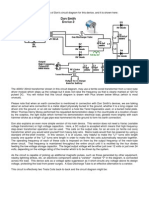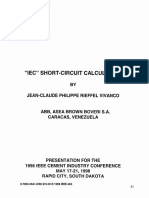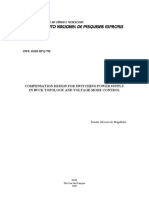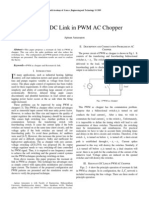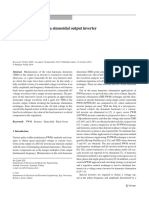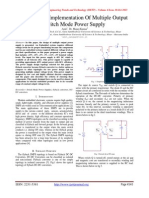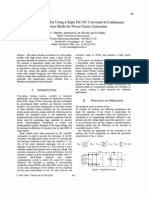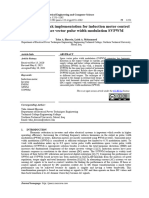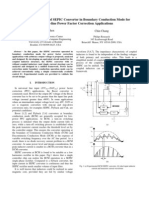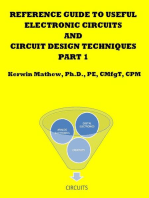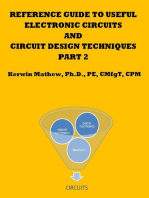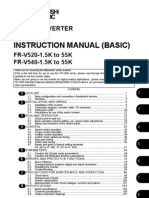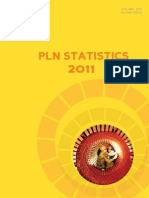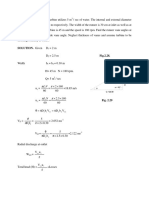Control of Indirect Matrix Converter Under Unbalanced Source Voltage and Load Current Conditions
Control of Indirect Matrix Converter Under Unbalanced Source Voltage and Load Current Conditions
Uploaded by
sweetu_adit_eeCopyright:
Available Formats
Control of Indirect Matrix Converter Under Unbalanced Source Voltage and Load Current Conditions
Control of Indirect Matrix Converter Under Unbalanced Source Voltage and Load Current Conditions
Uploaded by
sweetu_adit_eeOriginal Title
Copyright
Available Formats
Share this document
Did you find this document useful?
Is this content inappropriate?
Copyright:
Available Formats
Control of Indirect Matrix Converter Under Unbalanced Source Voltage and Load Current Conditions
Control of Indirect Matrix Converter Under Unbalanced Source Voltage and Load Current Conditions
Uploaded by
sweetu_adit_eeCopyright:
Available Formats
Fourth National Power Electronics Conference, IIT Roorkee, June - 2010
CONTROL OF INDIRECT MATRIX CONVERTER UNDER UNBALANCED SOURCE VOLTAGE AND LOAD CURRENT CONDITIONS
Mr. V. Y. Vekhande, Mr. B. B. Pimple and Prof. B. G. Fernandes Department of Electrical Engineering, Indian Institute of Technology Bombay, Mumbai ABSTRACT Doubly Fed Induction Generator (DFIG) is widely used along with AC-DC-AC converter for wind power generation. Merits and demerits of Indirect Matrix Converter (IMC) over AC-DC-AC converters are discussed in this paper. Detailed analysis is carried out for operation of IMC when unbalanced voltages are applied to IMC input and unbalanced voltages and currents derived at its output. Simulation results are presented for control strategy which eliminate sub-harmonic components in output and input currents caused due to unbalanced input voltages. INDEX TERMS Indirect Matrix Converter (IMC), Doubly Fed Induction Generator (DFIG), Unbalanced Grid Voltage INTRODUCTION DC-link capacitor occupies significant volume of conventional AC-DC-AC converter. Capacitor size depends on current rating and ripple contents. DC-link capacitor have shortest lifetime of any element used in power electronic converters. As the ambient temperature increases, its lifetime further decreases [1]. Indirect Matrix Converter (IMC) is an AC-DC-AC converter without DC-link capacitor. This converter topology is free from above mentioned problems associated with DC-link capacitor. It has features like bidirectional power flow capability, sinusoidal input currents with only high frequency switching harmonics and unity displacement power factor [2]. However, maximum voltage transfer ratio is limited to 0.866 [3]. Special care needs to be taken to overcome commutation problem. Variable speed generation scheme utilizing Doubly Fed Induction Generator (DFIG) is widely accepted solution for wind power generation. In DFIG, stator is directly connected to grid and rotor is connected to grid through AC-DC-AC converter. Controlled voltages are applied to rotor terminals to control active and reactive power flow between DFIG and grid [4]. For operation of DFIG up to 20-25% of slip, small voltages are required for rotor injection. So, IMC with limited voltage transfer ratio can be used for this particular application. IMC BASIC OPERATIONAL THEORY IMC Circuit Topology The rectifier section consists of six fully controlled bidirectional switches while inverter consists of six fully controlled unidirectional switches as shown in Fig. 1. Bidirectional switches are required to obtain a sinusoidal input current [5]. Rectifier section is capable of carrying current in both direction and produce positive or negative DC-link voltage. However, rectifier operation is restricted to produce positive average and instantaneous DClink voltage to avoid forward biasing of inverter section freewheeling diodes.
Figure 1. Indirect Matrix Converter Rectifier Operation Rectifier section is operated such that it produces maximum possible voltage with unity displacement factor at input. Only two switches will conduct at a time. Three phase input voltages are,
Fourth National Power Electronics Conference, IIT Roorkee, June - 2010
ua = ui cos(i t ) (1)
ib = d ab i ic = dac i
(7) (8)
ub = ui cos(i t
2 ) 3
(2) (3)
2 uc = ui cos(i t + ) 3
A phase input is clamped to the positive or negative bus in 3 -wide (60o) intervals when corresponding phase voltage has the highest absolute value. The other bus is toggled between remaining two phases. For example, if phase a is at its peak, then instantaneous value of DC-link voltage is u = uab or u = uac . Fig. 2 shows resultant DC-link voltage. Average value of DC-link voltage over pulse period TP is,
u = 3 1 ui 2 cos in
To achieve unity displacement factor, there should be proportional relationship between average value of an input phase current over pulse period TP and corresponding input phase voltage [2], [3]. i.e. voltage having higher magnitude will conduct for longer time. So,
dab = ib ub = ua ia
(9)
dac =
ic uc = ua ia
(10)
(4) (5)
For pulse period TP absolute conduction times are,
umin
3 = ui 2
ab = dab ac = d ac
TP 2 TP 2
(11) (12)
Average value of DC-link voltage over pulse period TP can also be written as,
u = uab d ab + uac dac
Inverter Operation
(13)
Inverter stage can be analyzed as normal VSI. It operates on pulsating DC-link voltage as shown in Fig. 2, formed by rectifier. Fig. 3 shows the operation of inverter in sector-I. The instantaneous values of active space vectors are,
u(100) =
2 u 3
(14)
Figure 2. DC-link Voltage
u(110) =
2 j ue 3 3
(15)
Let, dab = duty ratio of uab and d ac = duty ratio of uac In given pulse period, dab + dac = 1 If ia , ib , ic and i are average values of input phase a, b, c and DC-link currents respectively over pulse period TP . Then,
Let, (100) = absolute time period of u(100) and (110) = absolute time period of u(110) Output phase space vector is given by,
Tp 2 uoref = u(100) (100) + u(110) (110) (16)
Each active vector of inverter has two levels depending on rectifier switching condition.
ia = (dab + dac )i
(6)
Fourth National Power Electronics Conference, IIT Roorkee, June - 2010
Commutation
There are two methods to transfer rectifier current from one phase to the other.
First connect incoming phase and then open outgoing phase - which will momentarily short circuit the input phases. First open the outgoing phase and then connect the incoming phase - inductive current needs to be interrupted.
Figure 3. Sector-I of Inverter Space Vector Diagram [5]
Tp
2 2 uac (100),ac + uab (100),ab 2 3 3 j j 2 2 + uac e 3 (110),ac + uab e 3 (110),ab 3 3 uoref =
Both the conditions are undesirable and can be avoided by proper coordination between rectifier and inverter switching. 0 voltage vector is applied to inverter while transferring rectifier current from one phase to the other [3], [6]. It means, all output phases are connected to same bus which results in zero DC-link and rectifier currents. Now, rectifier current can be transferred safely using second method. Let, inverter vectors u1, u0 and u2 have time periods
(17)
1, 0 and 2 respectively. These time periods are
calculated from average DC-link voltage u over pulse period TP and reference output voltage requirement. r1 and r2 are time periods calculated for rectifier line voltages ur1 and
ur2 from unity displacement factor requirement of
Inverter active vectors u(100) and u(110) should be distributed in time periods ac and ab in same ratio as dac and dab . So,
(100),ac
(100),ac (100),ab = = (100),ab = = (100) (18) ac ab
rectifier. Time periods u1 , u0 and u2 are split into ratio such that,
(110),ac
(110),ac (110),ab = = (110),ab = = (110) (19) ac ab
u r u r
11
u r u r
0 1
u r u r
2 1
u u
r1
(23)
12
0 2
2 2
r2
So, output space vector expression is also given by, uoref = 2 2 u (100) + u (110) 3 3 (20)
These time periods are utilized to generate switching patterns for rectifier and inverter over one pulse period TP , as shown in Fig. 4.
Overall voltage transfer ratio is [3], M=
uoref 3 2 ui
(21)
Maximum voltage transfer ratio also depends on input power factor angle i [3],
uoref = M cos i ui (22)
It means, maximum voltage transfer ratio (0.866) is available only when input rectifier operates at unity power factor.
Figure 4. Rectifier and Inverter Switching Pattern in Pulse Period TP
Fourth National Power Electronics Conference, IIT Roorkee, June - 2010
Variable Power Factor at Rectifier Input
Let rectifier switching function is,
sw i = sw i e j (i t +i )
Average DC-link voltage can also be written as [5],
u=
(27)
3 ui m1 cos i 2
(24)
So, expression for input current in terms of DClink current is,
i1 = sw i i = e j (i t +i ) i ,(assume sw i = 1) (28)
If i is increased beyond 6 , then DC-link voltage has negative values for some instants and average DC-link voltage further reduces. Finally, when i = 2 , average DC-link voltage is zero [5]. However, negative DC-link voltage will forward bias the anti-parallel diodes across inverter IGBT switches. So, maximum possible adjustable input power factor angle can be achieved is 6 .
EFFECTS OF UNBALANCED INPUT/ OUTPUT SOURCE/ LOAD CONDITIONS
The instantaneous input power and DC-link power should be equal. Pi = 3 Re ui ii * = ui 2
{ }
(29) (30)
3 Re ui e j (i t +i ) i = ui 2
Substituting (26) in (30) and simplifying it further, gives the expression for DC-link voltage as, u= 3 u pi cos i + uni cos ( 2i t + i + nui ) 2
The IMC is to be used with DFIG for wind power generation. Wind power plants often installed in remote, rural areas. These remote areas usually have weak grids. The size of wind generator determines the PCC grid voltage level at which it will be connected. Single or group of small plants of 100-500 kVA are connected at low voltage grid at the consumer supply points. Generators in the range of 1-5 MVA are connected at distribution level (11-33 kV) [7]. At this level, the permissible limit of PCC voltage unbalance is upto 3% [10]. Under unbalanced grid voltage condition electromagnetic torque, stator currents, active and reactive powers have second harmonic pulsations. These pulsations cause mechanical stress, noise in turbine structure and unbalanced heating in stator windings of DFIG. Unbalanced voltages or currents are to be injected into DFIG rotor to compensate for effects of unbalanced grid voltages. So, it is necessary to analyze IMC operation under such conditions.
Effects of Unbalanced Input Voltages
(31)
This shows second harmonic component in DClink voltage. The inverter output voltage space vector can be expressed in terms of DC-link voltage as, uo = sw o e j (o t +o ) u 2 (32)
Substituting (31) in (32) and simplifying, it gives output voltage expression, uo = + + 3 4 3 4 3 sw o u pi cos i e j (o t +o ) 4 u sw o ni e j (2i t +o t +i +o +nui ) 2 u sw o ni e j (o t 2i t i +o nui ) 2
(33)
So, output voltage has fo , 2fi + fo
and 2fi fo
frequency components. Output current will have components same as output voltage. So, expression for output current space vector is,
For this analysis, it is assumed that input voltages at the rectifier terminals are unbalanced and load connected at the inverter terminals is balanced. Input voltage space vector can be written as, 2 ui = [ua + ub + 2uc ] 3
ui = u pi e j (i t ) + uni e j (i t +nui )
io = + +
u pi 3 sw o cos i e j (o t +o +o1 ) Z o1 4 (34)
uni 3 sw o e j (2i t +o t +i +o +nui +o 2 ) 4 2 Zo 2 uni 3 sw o e j (2i t o t +i o +nui +o 3 ) 4 2 Zo 3
(25)
In terms of +ve and -ve sequence components, (26)
From instantaneous power balance of inverter output and DC-link power,
Fourth National Power Electronics Conference, IIT Roorkee, June - 2010
Po = 3 Re uo io* = ui 2
(35) (36)
3 u Re sw o e j (o t +o ) io* = ui 2 2
Substituting (34) in (36) and simplifying, the expression for DC-link current is obtained as, i= + + 9 sw o 16
2
u pi Zo 1
cos i cos o1 (37)
uni 9 2 sw o cos(2i t + i + nui + o 2 ) 16 2 Zo 2 uni 9 2 sw o cos(2i t + i + nui + o 3 ) 16 2 Zo 3
Substituting in Equation (28) and simplifying, the expression for input current space vector is, ii = + + + 9 sw o 16
2
u pi Zo 1
cos i cos o1e j (i t +i )
uni 9 2 sw o e j (3i t + 2i +nui +o 2 ) 16 4 Zo 2 uni 9 2 sw o e j (i t +nui +o 2 ) 16 4 Zo 2 uni 9 2 sw o e j (3i t + 2i +nui +o 3 ) 16 4 Zo 3 (38)
Figure 5. Frequency Spectrum of Output Current: (a) Without Unbalance Compensation and (b) With Unbalance Compensation Effects of Unbalanced Output Currents
uni 9 2 sw o e j (i t +nui +o 3 ) + 16 4 Zo 3 This shows input current has frequency components of fi and 3fi . So, with unbalanced input voltages, DC-link has second harmonic and input current has harmonic component thrice the input frequency [8]. In above analysis, it is assumed that the rectifier and inverter operate with balanced switching function. However, balanced output voltages can be produced by using unbalanced inverter switching function. For this, an average DC-link voltage u is calculated for each pulse period. At the start of each pulse period the modulation index is calculated for that pulse period based on u of previous pulse period. This variable modulation index control strategy eliminates 2fi + fo and 2fi fo frequency components in output current as shown in Fig. 5 and 3fi component in input current as shown in Fig. 6.
Inverter section of IMC may have to produce unbalanced currents if unbalanced output voltages are applied to balanced loads or balanced output voltages are applied to unbalanced loads. So, output current space vector consists of +ve and -ve sequence components [9].
io =
2 [ i A + i B + 2 iC ] 3
j ( o t +po )
(39) (40)
io = i po e
+ i no e j (o t +no )
The instantaneous output and DC-link powers should be equal.
Po =
3 Re uo io* = ui 2
(41)
The inverter output voltage can be represented in terms of DC-link voltage and inverter switching function.
Fourth National Power Electronics Conference, IIT Roorkee, June - 2010
This shows that IMC input currents have frequency components fi , 2fo + fi and 2fo fi .
CONCLUSION
IMC could be an alternative for AC-DC-AC conversion. It has bidirectional power flow capability. Analysis of IMC is carried out for unbalanced input voltages and unbalanced output currents. Effects of unbalanced input voltages on output and input currents are eliminated by dynamically varying modulation index of inverter section.
REFERENCES
[1] (2001). Life-Limiting Factors in Electrolytic Capacitors (and how to improve them) [Online]. Available: http://www.evoxrifa.com/technote\_pdf/electrolyti c\_life\_factors.pdf [2] L. Wei and T. A. Lipo, A Novel Matrix Converter Topology with Simple Commutation, in Conf. Rec. 2001 IEEE, Industrial Applications Conference, 2001, 36th IAS Annu. Meeting, vol. 3, pp. 1749 - 1754. [3] J. W. Kolar, F. Schafmeister, S. D. Round and H. Ertl, Novel Three-Phase AC-AC Sparse Matrix Converters, IEEE Trans. Power Electronics, vol. 22, pp. 1649 - 1661, Sept. 2007. [4] F. Poitiers, T. Bouaouiche and M. Machmoum, Advanced control of a doubly-fed induction generator for wind energy conversion, ScienceDirect Electrical Power System Research, vol. 79, pp. 1085-1096, July 2009. [5] J. W. Kolar, T. Friedli, F. Krismer and S. D. Round, The Essence of Three-Phase AC/AC Converter Systems, in 2008 Power Electronics and Motion Control Conf., pp. 27-42, Sept. 2008. [6] L. Wei, T. A. Lipo and H. Chan, Matrix Converter Topologies With Reduced Number of Switches, in 2002 Power Electronics Specialists Conf., vol. 1, pp. 57-63, June 2002. [7] R. N. Nayak. (2008, Nov. 25). Power Quality Issues and Grid Interconnection Code: An Indian case study [Online]. Available: http://windindia08.wisein.org/wind-india-08presentations.htm
Figure 6. Frequency Spectrum of Input Current: (a) Without Unbalance Compensation and (b) With Unbalance Compensation
uo = sw o e j (o t +o ) u 2
(42)
Substituting (40) and (42) in (41) and simplifying, gives the expression for DC-link current as,
i= 3 sw o i po cos(o po ) 4
3 + sw o i no cos(2o t + o + no ) 4
(43)
The input current is defined with the help of rectifier switching function and DC-link current.
ii = sw i e j (i t +i ) i
(44)
Substituting and simplifying gives expression for rectifier input current as, ii = + + 3 4 3 4 3 sw o i po cos(o po )e j (i t +i ) 4 i sw o no e j (2o t +i t +i +o +no ) 2 i sw o no e j (2o t i t i +o +no ) 2
(45)
Fourth National Power Electronics Conference, IIT Roorkee, June - 2010
[8] P. N. Enjeti and S. A. Choudhury, A New Control Strategy to Improve the Performance of a PWM AC to DC Converter under Unbalanced Operating Conditions, IEEE Trans. Power Electronics, vol. 8, pp. 493-500, Oct. 1993. [9] M. Jussila and H. Tuusa, Illustration of Relation between Load and Supply Current Distortion in Direct and Indirect Matrix Converters, in Power Electronics Specialist Conf., pp. 2522-2528, June 2007. [10] The Central Electricity Authority (Technical Standards for Connectivity to the Grid) Regulations, 2007, 2/X/STD(CONN)/GM/CEA, Feb. 2007. Vishal Y. Vekhande was born in Mumbai, Maharashtra, India in 1983. He received the B.E. degree in electrical engineering from the VJTI, Mumbai, India, in 2005. After graduation he worked with Siemens Ltd. for two years as an Executive engineer. He is currently working towards the M.Tech. degree in Power Electronics and Power Systems at Indian Institute of Technology Bombay, Mumbai, India. His current research interests include applications of Matrix converter and DFIG for wind power generation. B. B. Pimple was born in Buldana, India in 1973. He received the B.E. degree in electrical engineering from Government College of Engineering , Amaravati, India in 1996 and the M. Tech. degree from the Visvesvaraya Regional College of Engineering, Nagpur, India in 1998. He joined as a lecturer at Sardar Patel College of Engineering Mumbai in 1998 and presently he is an Assistant Professor. He is currently working towards the Ph.D. degree in the Department of Electrical Engineering, Indian Institute of Technology Bombay. His current research interests are control of doubly-fed induction generator for wind power generation and matrix converter. B. G. Fernandes received the B. Tech. degree from Mysore University, Mysore, India, in 1984, the M. Tech. degree from the Indian Institute of Technology, Kharagpur, India, in 1989, and the Ph.D. degree from the Indian Institute of Technology Bombay, Mumbai, India, in 1993. He was with the Department of Electrical Engineering, Indian Institute of Technology, Kanpur, India, as an Assistant Professor. Since 1997, he has been with the Department of Electrical Engineering, Indian Institute of Technology Bombay, where he is currently a Professor. His current research interests are permanent-magnet machines, high-performance ac drives, quasi-resonant link converter topologies, and power electronic interfaces for nonconventional energy sources.
You might also like
- 14450589-Repair Manual Mercury 40 50 60 HP Outboard 2002-2007Document590 pages14450589-Repair Manual Mercury 40 50 60 HP Outboard 2002-2007Adrian Radoi88% (8)
- SCR100 Charger Installation & Operating Instructions, 2002-09-02Document38 pagesSCR100 Charger Installation & Operating Instructions, 2002-09-02priyanka236No ratings yet
- Unit-I Economic Operation: TOPICS: Optimal Operation of Generators in Thermal Power Stations, - HeatDocument32 pagesUnit-I Economic Operation: TOPICS: Optimal Operation of Generators in Thermal Power Stations, - Heatnadeem100% (5)
- ELX303 Exam SolutionsDocument27 pagesELX303 Exam SolutionsNadeesha BandaraNo ratings yet
- Square Wave GeneratorDocument6 pagesSquare Wave GeneratorRahul Kundu100% (2)
- Zilano 2Document22 pagesZilano 2blargbl100% (5)
- Ansi-C84 1Document23 pagesAnsi-C84 1Oswaldo Ordoñez ParapiNo ratings yet
- B767 200-300 BOOK 24 101 - Electrical PowerDocument34 pagesB767 200-300 BOOK 24 101 - Electrical PowerTarik Benzineb100% (1)
- D Single Phase Fully: Esign of Controlled Converter Using Cosine Wave Crossing Control With Various ProtectionsDocument6 pagesD Single Phase Fully: Esign of Controlled Converter Using Cosine Wave Crossing Control With Various Protectionsঅর্ণব কোলেNo ratings yet
- Fine Tuning of Cascaded D-Q Axis Controller For AC-DC-AC Converter Without DC Link Capacitor Using Artificial Neural NetworkDocument8 pagesFine Tuning of Cascaded D-Q Axis Controller For AC-DC-AC Converter Without DC Link Capacitor Using Artificial Neural NetworkHedra GirgisNo ratings yet
- Digital Control of A Three Phase 4 Wire PWM Inverter For PVDocument9 pagesDigital Control of A Three Phase 4 Wire PWM Inverter For PV7788778887No ratings yet
- Wineyard - in Abstract Mtech Electronics BP 14PE3 PDFDocument5 pagesWineyard - in Abstract Mtech Electronics BP 14PE3 PDFbhulakshmideviNo ratings yet
- A Single Stage Flyback Power Supply Unit For LED Lighting ApplicationsDocument5 pagesA Single Stage Flyback Power Supply Unit For LED Lighting ApplicationsPhạm Văn TưởngNo ratings yet
- The Use of Harmonic Distortion To Increase The Output Voltage of A Three Phase VSI PDFDocument5 pagesThe Use of Harmonic Distortion To Increase The Output Voltage of A Three Phase VSI PDFobulapathiNo ratings yet
- IEC Short Circuit CalculationDocument16 pagesIEC Short Circuit CalculationJoselito Vaca50% (2)
- VVV VV V V VDocument2 pagesVVV VV V V Vfrizbee45No ratings yet
- Overlap 9Document5 pagesOverlap 9padmasiri1No ratings yet
- CUK ConverterDocument4 pagesCUK Converterranjitheee1292No ratings yet
- The International Conference On Renewable Energies: "ICRE-2010"Document30 pagesThe International Conference On Renewable Energies: "ICRE-2010"M VetriselviNo ratings yet
- The Use of Facts Devices in Disturbed Power Systems-Modeling, Interface, and Case StudyDocument5 pagesThe Use of Facts Devices in Disturbed Power Systems-Modeling, Interface, and Case StudyNoppon PatNo ratings yet
- A Novel Aeronautical Static Inverter With High Frequency Pulse DC Link PDFDocument8 pagesA Novel Aeronautical Static Inverter With High Frequency Pulse DC Link PDFqiwatingNo ratings yet
- Public A CaoDocument23 pagesPublic A CaoShaheer DurraniNo ratings yet
- FarhangiDocument5 pagesFarhangiSijeo PhilipNo ratings yet
- Maximum Power Injection Acceptance in A Residential AreaDocument6 pagesMaximum Power Injection Acceptance in A Residential AreaAnonymous NGXdt2BxNo ratings yet
- Control Strategy For Three-Phase PWM Boost Rectifier Operating Under Different Supplyvoltage ConditionsDocument18 pagesControl Strategy For Three-Phase PWM Boost Rectifier Operating Under Different Supplyvoltage ConditionsHoàngMạnhTuấnNo ratings yet
- 20 The Essence of ThreePhase INTELEC2011Document28 pages20 The Essence of ThreePhase INTELEC2011noreuNo ratings yet
- Novel, Switch, Z-Source Three-Phase InverterDocument6 pagesNovel, Switch, Z-Source Three-Phase InverterJanjanam PraveenNo ratings yet
- Analysis and Design For 5kw PFC ConverterDocument4 pagesAnalysis and Design For 5kw PFC Converterranjith120198No ratings yet
- M.g.say ch01Document5 pagesM.g.say ch01prabhjot singh150% (2)
- Zrzpz3Iv0: FilterDocument7 pagesZrzpz3Iv0: FilterNguyen Yen MaiNo ratings yet
- Modified Valley-Fill For Harmonics ReductionDocument4 pagesModified Valley-Fill For Harmonics ReductionAyong HiendroNo ratings yet
- Base (Reference) PaperDocument7 pagesBase (Reference) Papermphaniteja2012No ratings yet
- 05666416Document6 pages05666416asjokiiu546No ratings yet
- Resonant DC Link in PWM AC ChopperDocument5 pagesResonant DC Link in PWM AC ChopperMukesh SharmaNo ratings yet
- Single Phase Full Bridge Inverter With Coupled Filter Inductors and Voltage Doubler For PV Module Integrated Converter SystemDocument7 pagesSingle Phase Full Bridge Inverter With Coupled Filter Inductors and Voltage Doubler For PV Module Integrated Converter Systemd_wiNo ratings yet
- A New Control Scheme of A Cascaded Transformer Type Multilevel PWM Inverter For A Residential Photovoltaic Power Conditioning SystemDocument12 pagesA New Control Scheme of A Cascaded Transformer Type Multilevel PWM Inverter For A Residential Photovoltaic Power Conditioning Systemmj5995No ratings yet
- Yamada 2014Document11 pagesYamada 2014Bhargav ReddyNo ratings yet
- Facts Devices - Solution ManualDocument16 pagesFacts Devices - Solution ManualBirendra Kumar DebtaNo ratings yet
- Design and Implementation of Cosine Control Firing Scheme For Single Phase Fully Controlled Bridge RectifierDocument7 pagesDesign and Implementation of Cosine Control Firing Scheme For Single Phase Fully Controlled Bridge RectifierNishith DhinoraNo ratings yet
- Efficiency Optimization of An Automotive Multi-Phase Bi-Directional DC-DC ConverterDocument7 pagesEfficiency Optimization of An Automotive Multi-Phase Bi-Directional DC-DC ConverterB.Kailash Krishna PrasadNo ratings yet
- Of Loop AC: Design Feedback in Unity Power Factor To DC ConverterDocument9 pagesOf Loop AC: Design Feedback in Unity Power Factor To DC ConverterEjaz AhmedNo ratings yet
- 2023-24 - Cit-Eee-Ii Mid Sem-Answer Key-19ee61-Power ElectronicsDocument28 pages2023-24 - Cit-Eee-Ii Mid Sem-Answer Key-19ee61-Power ElectronicsBhoomika SNo ratings yet
- ELEC5562M Unit 4 - Activities Long QuestionsDocument6 pagesELEC5562M Unit 4 - Activities Long Questionssaiedali2005No ratings yet
- Unit - 2Document4 pagesUnit - 2mikeNo ratings yet
- 29.voltage Flicker Compensation Using STATCOMDocument6 pages29.voltage Flicker Compensation Using STATCOMdeepu227No ratings yet
- Design and Implementation of PFC CUK Converter-Based PMBLDCM DriveDocument5 pagesDesign and Implementation of PFC CUK Converter-Based PMBLDCM Drivesarav03No ratings yet
- Power Electronic Module - Chapter 3Document34 pagesPower Electronic Module - Chapter 3jayxcellNo ratings yet
- Modeling and Simulation of PMSG Based Wecs: Jamuna V Baskar M Senthoorselvam DDocument5 pagesModeling and Simulation of PMSG Based Wecs: Jamuna V Baskar M Senthoorselvam DSundaraPandiyanNo ratings yet
- A Novel Approach For A Sinusoidal Output Inverter: Irfan AlanDocument6 pagesA Novel Approach For A Sinusoidal Output Inverter: Irfan AlanKari Romero GuizasolaNo ratings yet
- Design and Implementation of Multiple Output Switch Mode Power SupplyDocument6 pagesDesign and Implementation of Multiple Output Switch Mode Power SupplyseventhsensegroupNo ratings yet
- Assignment2 2015Document1 pageAssignment2 2015AndrewJohnsonJenssonNo ratings yet
- Three-Phase Rectifier Using A Sepic DC-DC Converter in Continuous Conduction Mode For Power Factor CorrectionDocument7 pagesThree-Phase Rectifier Using A Sepic DC-DC Converter in Continuous Conduction Mode For Power Factor CorrectionuakragunathanNo ratings yet
- Power Factor Correction AC-DC Boost Converter Using PI-hysteresis Current ControlDocument7 pagesPower Factor Correction AC-DC Boost Converter Using PI-hysteresis Current ControlInternational Journal of Power Electronics and Drive SystemsNo ratings yet
- Wcecs2009 - pp545-549 Computer LoadsDocument5 pagesWcecs2009 - pp545-549 Computer LoadsYogesh MsdNo ratings yet
- Uncontrolled Three Phase RectifiersDocument19 pagesUncontrolled Three Phase RectifiersTetsusaigaNo ratings yet
- PDFDocument13 pagesPDFhieuhuech1No ratings yet
- Switched Capacitor Signal Conditioning For Push-Pull Type Capacitive SensorsDocument4 pagesSwitched Capacitor Signal Conditioning For Push-Pull Type Capacitive SensorssriraghavrNo ratings yet
- 12 12 2013 11 58 43 PDFDocument8 pages12 12 2013 11 58 43 PDFDante FilhoNo ratings yet
- Modified Z-Source Single-Phase Inverter For Single-Phase PM Synchronous Motor DrivesDocument6 pagesModified Z-Source Single-Phase Inverter For Single-Phase PM Synchronous Motor DrivesPRACHI KATARENo ratings yet
- Electrical Engineering Full Paper 2007Document27 pagesElectrical Engineering Full Paper 2007Khatri RaviNo ratings yet
- Detailed Simulink Implementation For IndDocument12 pagesDetailed Simulink Implementation For IndbmefhyNo ratings yet
- A Novel Buck Boost InverterDocument8 pagesA Novel Buck Boost InverterskrtamilNo ratings yet
- An Inverter SystemDocument20 pagesAn Inverter Systemselaroth168No ratings yet
- Analysis and Design of SEPIC Converter in Boundary Conduction Mode For Universal-Line Power Factor Correction ApplicationsDocument6 pagesAnalysis and Design of SEPIC Converter in Boundary Conduction Mode For Universal-Line Power Factor Correction ApplicationsxynthianNo ratings yet
- Reference Guide To Useful Electronic Circuits And Circuit Design Techniques - Part 1From EverandReference Guide To Useful Electronic Circuits And Circuit Design Techniques - Part 1Rating: 2.5 out of 5 stars2.5/5 (3)
- Reference Guide To Useful Electronic Circuits And Circuit Design Techniques - Part 2From EverandReference Guide To Useful Electronic Circuits And Circuit Design Techniques - Part 2No ratings yet
- Ignition Systems: Point Style (Conventional) & Electronic StylesDocument27 pagesIgnition Systems: Point Style (Conventional) & Electronic Stylessweetu_adit_eeNo ratings yet
- Wiener Filter Design in Power Quality ImprovmentDocument8 pagesWiener Filter Design in Power Quality Improvmentsweetu_adit_eeNo ratings yet
- CH 31 Ignition System ComponentsDocument41 pagesCH 31 Ignition System Componentssweetu_adit_eeNo ratings yet
- Optimal Dispatch of Generation Part I: Unconstrained Parameter OptimizationDocument9 pagesOptimal Dispatch of Generation Part I: Unconstrained Parameter Optimizationsweetu_adit_eeNo ratings yet
- 9032 Experiment 02Document7 pages9032 Experiment 02sweetu_adit_ee100% (1)
- Ed Manual 2Document114 pagesEd Manual 2Surbhi SinghNo ratings yet
- 6.013 Electromagnetics and Applications: Mit OpencoursewareDocument13 pages6.013 Electromagnetics and Applications: Mit Opencoursewaresweetu_adit_eeNo ratings yet
- Afrison Solar CatalogueDocument53 pagesAfrison Solar CatalogueCassandra StapelbergNo ratings yet
- Load Studies and Effects of Load VariationDocument14 pagesLoad Studies and Effects of Load VariationAreeba Mushtaq AhmedNo ratings yet
- Power Crisis in The PhilippinesDocument4 pagesPower Crisis in The PhilippinesRenz Anthony EspinoNo ratings yet
- Hydropower Plant Automation Using MicrocontrollerDocument4 pagesHydropower Plant Automation Using MicrocontrolleradinavakanthNo ratings yet
- PV Grid Integration: Backgrounds, Requirements, and SMA SolutionsDocument36 pagesPV Grid Integration: Backgrounds, Requirements, and SMA SolutionsParthibanPerumalNo ratings yet
- Governor Mode of OperationDocument12 pagesGovernor Mode of OperationSanjeet Saud100% (3)
- TOP 200 ELECTRICAL ENGINEERING Interview Questions and Answers - EEE Electrical Engineering Interview QuestionsDocument26 pagesTOP 200 ELECTRICAL ENGINEERING Interview Questions and Answers - EEE Electrical Engineering Interview QuestionsPrashant Pandey100% (2)
- Utility Scale 1 MW Solar Power GenerationDocument34 pagesUtility Scale 1 MW Solar Power Generationkaranbhadu100% (1)
- Cyclo Converter 1Document46 pagesCyclo Converter 1basabNo ratings yet
- Rolls Royce Gas Engine of 5.255 MWDocument1 pageRolls Royce Gas Engine of 5.255 MWRashid Mahmood0% (1)
- Mitsubishi v500 VFD Instruction ManualDocument119 pagesMitsubishi v500 VFD Instruction ManualMROstop.com100% (1)
- Voltage RegulationDocument6 pagesVoltage RegulationjaykantpanditNo ratings yet
- Class A AmplifiersDocument23 pagesClass A AmplifiersDaniel BermodezNo ratings yet
- P-L-N-Statistik 2011Document104 pagesP-L-N-Statistik 2011Ahmad AfandiNo ratings yet
- 4 Standards For AC Motors PDFDocument37 pages4 Standards For AC Motors PDFEdú BrizuelaNo ratings yet
- VFDDocument4 pagesVFDchandrakanth100% (2)
- MOGE Presenation 2011Document44 pagesMOGE Presenation 2011arakanoilwatchNo ratings yet
- Rig 104 InventoryDocument16 pagesRig 104 InventorypetricamafteiNo ratings yet
- Topward 6303 ADocument18 pagesTopward 6303 AJean-Paul TaritNo ratings yet
- T 2Document9 pagesT 2Amaterasu Susanoo TsukuyomiNo ratings yet
- Toshiba VFS9Document12 pagesToshiba VFS9PùbùdùPathirathnaNo ratings yet
- Summer Industrial Training ReportDocument26 pagesSummer Industrial Training ReportAbhishek SinghNo ratings yet
- DesignVerification SYS1Document20 pagesDesignVerification SYS1Geir Arne HagbyNo ratings yet
- IEEE PES - Interconnected Power System Response To Generation GoverningDocument127 pagesIEEE PES - Interconnected Power System Response To Generation Governingsulemankhalid100% (1)





